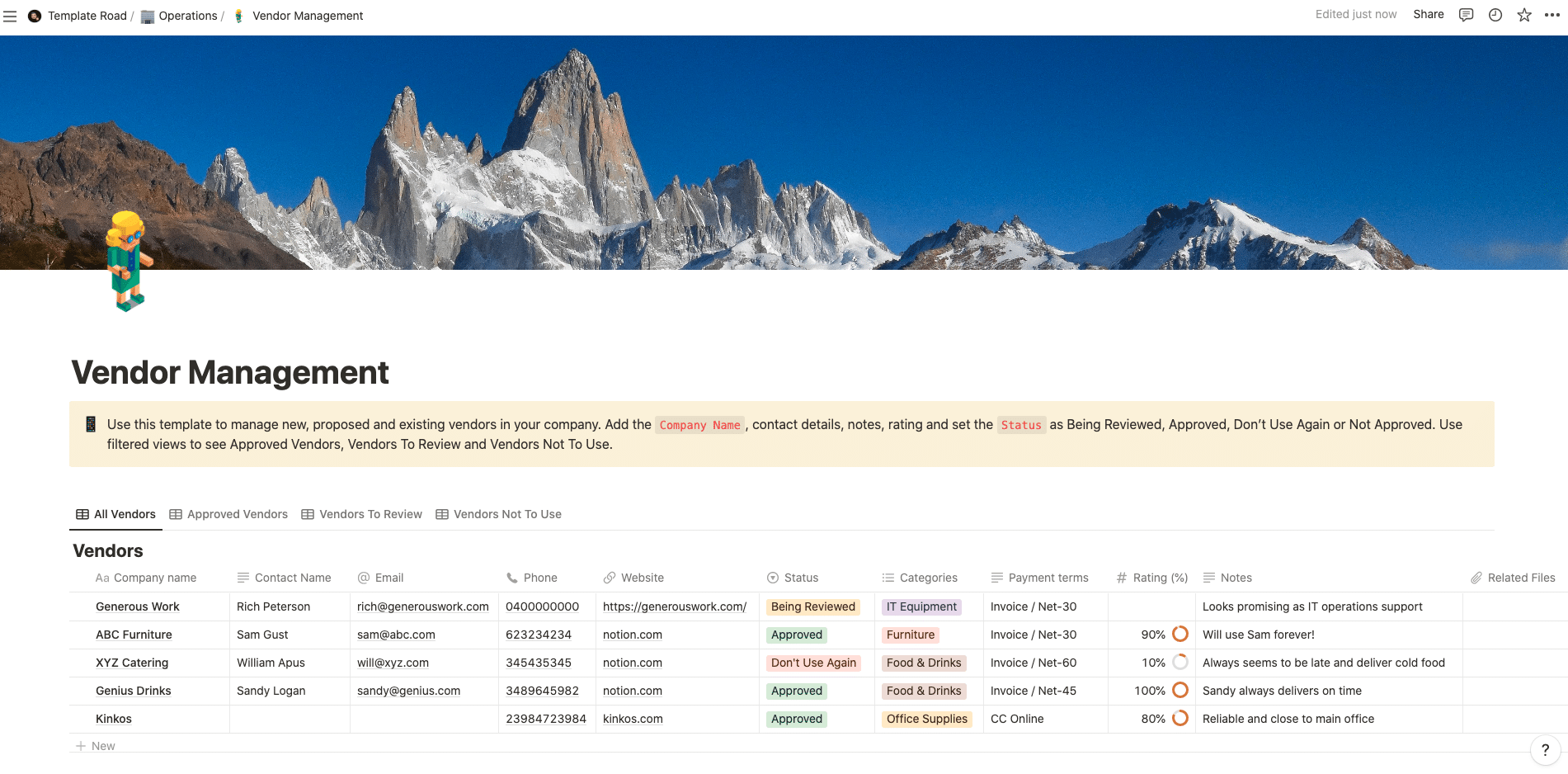Use this template to manage new, proposed and existing vendors in your company.
Buy on
Notion – Vendor Management Template
Use this template to manage new, proposed and existing vendors in your company. Add the Company Name, contact details, notes, rating and set the Status as Being Reviewed, Approved, Don’t Use Again or Not Approved. Use filtered views to see Approved Vendors, Vendors To Review and Vendors Not To Use. Third-party vendors are critical for the success of today’s business organisations. Outsourcing various activities and bringing vendors on board necessitates the recording of their key information such as rates, contact details and agreements. The use of Excel sheets, shared drives and Word documents to manage this data is no longer adequate.
——————————————
What you need before purchase
- Basic knowledge of how to use Notion
- Paid Notion account if you want to add lots of content to your template / Notion account (sign up here). Not much content? You’re able to use their free account.
After purchase, you’ll be able to view the template immediately. The template can be added to your Notion account by:
- Click on the template download link in Gumroad
- When viewing the Notion template, click on the “Duplicate” link in the top-right of your screen
- The template will now be available in your own Notion account
How to manage vendors well
Managing a network of vendors and suppliers may be difficult, but it’s critical to reach objectives that you can’t accomplish on your own. However, if you don’t have a central location where you can communicate, keep contracts, and establish work plans, it’s difficult to know whether or not tasks are being done correctly. Here are some pointers to get you started or take the next step.
- Make vendor management part of your work plan
- Get everyone involved early on
- Take an active role in vendor management
- Manage your vendors based on their business model
1. Make vendor management part of your work plan
Start by making the process of managing vendors and suppliers a regular part of your work plan. Different companies organize this in different ways; whatever works for you is best, so long as it’s done regularly. Some things to consider:
- How often should we meet?
- What questions will we answer?
- Who needs to be involved?
- What do we need from each other?
How will we keep everyone informed about what’s going on?
2. Get everyone involved early on
Involve people from the very beginning, as soon as you have a strategy for managing your vendors. They can help you figure out how best to communicate, how often to get together, and the kind of information you’ll need to share so everyone stays on top of what’s going on.
3. Take an active role in vendor management
Managing vendors can be difficult if it’s not always clear who is responsible for what. Many companies find it useful to have a lead person or committee manage the process. That way, it’s clear who is in charge and who to turn to when there are problems.
4. Manage your vendors based on their business model
Vendors and suppliers fall into four categories: sales only, sales/service, service only, and owner/operator. Each has its own needs, so it makes sense to treat them all differently. For example:
Sales-only companies need work plans and contracts. They also want their services to be clearly defined so they know what’s included in the cost of doing business. Sales-only companies like to understand how much time you spend with each supplier, who does what work, and whether the supplier’s staff are subcontractors or employees.
Sales/service companies are usually familiar with your products or services, but may not know you well. They help you sell your product so it helps if they understand your customers and where you fit in. A service-only company wants to know how often you plan on using their service so they can meet your needs.
Service-only companies need to have a clear process for work requests, which brings us to another helpful tip: if there are multiple vendors that provide similar services, consider having all of them do the same thing at different prices. This way, when something goes wrong with one supplier, they can easily be replaced without transferring knowledge of the previous supplier.
It helps to talk to your vendors and suppliers about their business model so you can manage them accordingly.















